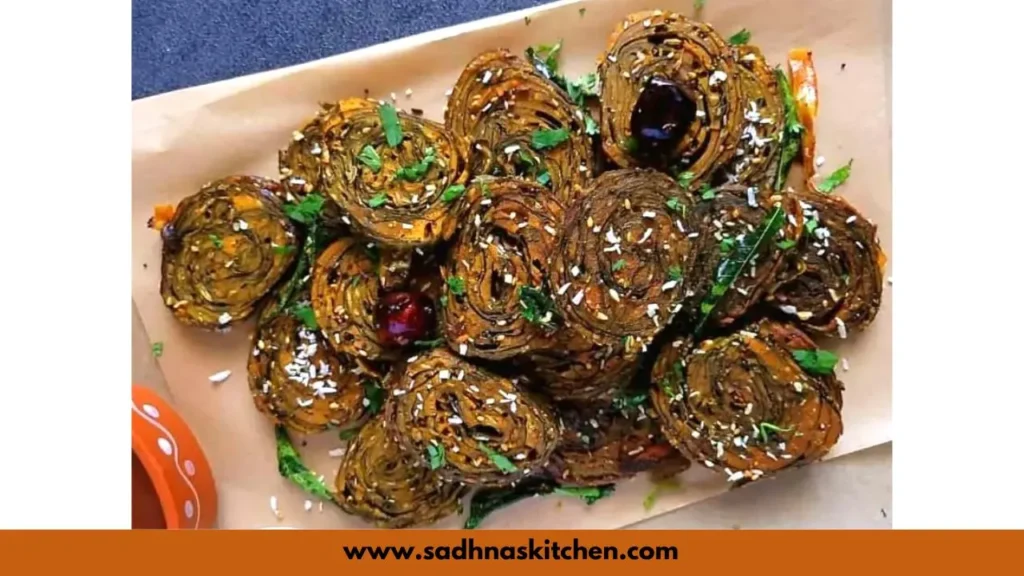If you’ve never had Gujarati Patra, also known as Alu Vadi in Maharashtra, get ready to fall in love with this unique snack. It’s made by slathering a sweet, spicy, and tangy gram flour paste onto colocasia (arbi) leaves, rolling them up, steaming, and slicing them into savory pinwheels. A final tempering of mustard seeds, sesame, and curry leaves adds irresistible crunch and flavor.
Crispy on the outside, soft inside, and bursting with flavor, Patra is one of those traditional snacks that truly hits all the right notes.
Similar Recipes
What is Patra?
“Patra” means leaf in Gujarati, and this dish makes brilliant use of arbi (colocasia) leaves, which are commonly available at Indian stores or farmers’ markets. The spiced besan (gram flour) paste is what gives it its signature sweet-tangy-spicy flavor profile. Once steamed and sliced, the rolls are tempered to create a perfect contrast of textures.
Whether served at tea time, during festivals, or as a party appetizer, Patra is always a hit!
Ingredients
For the Rolls:
- 5–6 large colocasia (arbi) leaves, fresh and washed
- 1 cup besan (gram flour)
- 2 tbsp tamarind pulp
- 1½ tbsp jaggery, grated or powdered
- 1 tsp red chili powder
- ½ tsp turmeric powder
- 1 tsp cumin-coriander powder
- 1 tsp sesame seeds (for the paste)
- Salt, to taste
- Water, to make a thick paste
For Tempering:
- 1½ tbsp oil
- 1 tsp mustard seeds
- 1 tsp sesame seeds
- A pinch of asafoetida (hing)
- Few curry leaves
Optional Garnish:
- Grated coconut
- Chopped fresh coriander
How to Make Gujarati Patra
1. Prep the Leaves
- Trim the thick stems and veins using a knife or peeler to flatten each leaf.
- Pat them dry completely with a clean kitchen towel.
2. Make the Spiced Besan Paste
- In a mixing bowl, combine besan, tamarind pulp, jaggery, chili powder, turmeric, cumin-coriander powder, sesame seeds, and salt.
- Gradually add water and whisk into a smooth, thick paste—think pancake or cake batter consistency.
3. Layer & Roll
- Place one leaf smooth side down. Spread a thin, even layer of the besan paste.
- Place another leaf on top (facing the opposite direction if smaller), and repeat layering.
- Usually, 3–4 leaves make one roll.
- Fold in the sides and roll tightly into a firm log.
- Repeat to make 2–3 rolls.
4. Steam the Rolls
- Place rolls in a steamer or idli cooker. Steam for 20–25 minutes on medium heat.
- Insert a knife or toothpick—if it comes out clean, they’re done.
- Let the rolls cool completely before slicing them into ½-inch rounds.
5. Temper and Finish
- Heat oil in a skillet. Add mustard seeds, sesame seeds, hing, and curry leaves.
- Once they splutter, gently add the patra slices.
- Toss or pan-fry for 3–4 minutes, until lightly crisped and golden.
6. Garnish (Optional)
- Sprinkle with grated coconut and fresh cilantro before serving.
Tips for Perfect Patra
- Use young, tender colocasia leaves for easy rolling and better taste.
- Always let the rolls cool before slicing to avoid breakage.
- Want it extra crispy? Try shallow frying or air frying the slices after steaming.
- Add crushed peanuts to the tempering for a crunchy twist.
Nutrition Facts (Per 3–4 pieces)
| Nutrient | Amount |
|---|---|
| Calories | ~120 kcal |
| Carbohydrates | ~15g |
| Protein | ~4g |
| Fat | ~5g |
| Fiber | ~3g |
| Sodium | ~180mg |
Nutrition values are approximate and may vary depending on ingredient quantities.
Final Thoughts
Gujarati Patra is more than just a snack; it’s tradition wrapped in leaves. It’s high in fiber, packed with flavor, and easy to make once you get the hang of it. Serve it warm with a cup of chai, as a starter at your next dinner party, or as part of a festive platter.
Looking for a Jain-friendly or baked version? Drop a comment, and I’d be happy to share!

